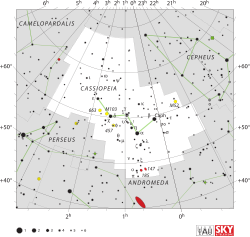Cassiopeia is a constellation in the northern sky. It was named after a queen in Greek mythology called Cassiopeia. It looks like a letter W or M, with five bright stars that make the W or the M shape. It has two very bright stars called ρ Cas and V509 Cas.
| Constellation | |
 | |
| Abbreviation | Cas |
|---|---|
| Genitive | Cassiopeiae |
| Pronunciation | /ˌkæsi.əˈpiː.ə/ Cássiopéia, colloquially /ˌkæsiˈoʊpiː.ə/ Cássiópeia; genitive /ˌkæsi.əˈpiː.iː/ |
| Symbolism | the Seated Queen |
| Right ascension | 1 |
| Declination | +60 |
| Quadrant | NQ1 |
| Area | 598 sq. deg. (25th) |
| Main stars | 5 |
| Bayer/Flamsteed stars | 53 |
| Stars with planets | 5 |
| Stars brighter than 3.00m | 4 |
| Stars within 10.00 pc (32.62 ly) | 7 |
| Brightest star | α Cas (Schedar) (2.15m) |
| Messier objects | 2 |
| Meteor showers | Perseids |
| Bordering constellations | Camelopardalis Cepheus Lacerta Andromeda Perseus |
| Visible at latitudes between +90° and −20°. Best visible at 21:00 (9 p.m.) during the month of November. | |

In 1572, a supernova called Tycho's Star, or SN 1572, was seen in Cassiopeia by many people. The best time to look for Cassiopeia is in late fall (September and early November.)